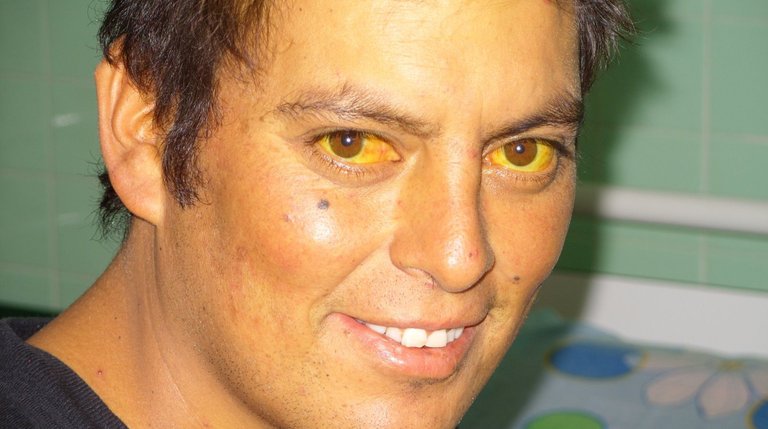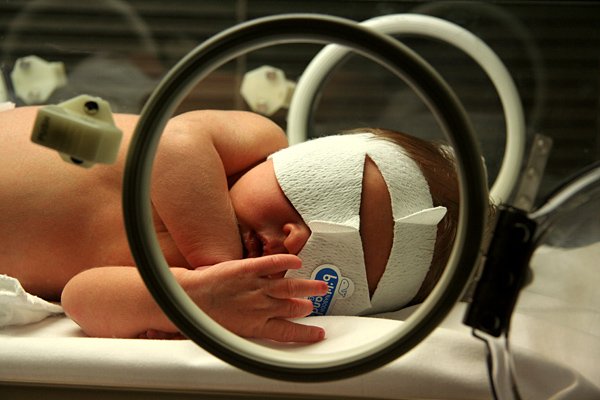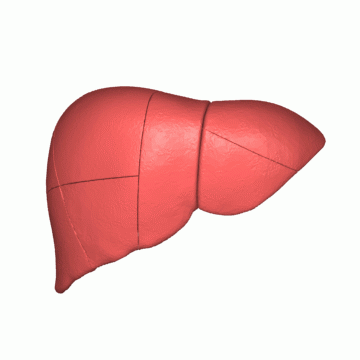A dangerous disease that causes yellowish skin discoloration on neonates.
Hello lovely people, I hope everyone is great here? It's really been a while, and I must admit that I feel uncomfortable anytime am not able to drop a post here due to my work schedule. So I tried this time around to make out time to write on this important topic inorder to enlighten us as usual.
I want to seize this opportunity to encourage us to patiently read through this article, because there might be few or even many things you can learn from it, just get a bottle of water or drink that will relax your nerves while you read.
Previously I talked about the kangaroo care for newborns especially the prematured ones in my last post, which I know was really beneficial to some persons here.
Today I will be discussing about a disease condition that is very common amongst babies especially within the first 1 month of their life, which could be dangerous if not identified early. Your attention is important here because you could pick something that will save your baby or even someone else's baby.
I know by now you may be wondering
about the disease am referring to. Well, it's no other thing than Neonatal jaundice.
Neonatal Jaundice (Hyperbilirubinemia)
In simple terms, neonatal jaundice is a disease condition that occurs in newborns (either prematured or matured), within 28days of age after delivery which is characterized by yellowish discoloration of the sclera( the white part of the eye),or the skin of the baby with it's associated symptoms, and it is due to the accumulation of bilirubin especially the unconjugated ones in the blood.
This particular disease condition usually affects the prematured babies more because their liver are not yet matured which results to it's inability to carry out it's functions.

A typical example of what yellowish discoloration of skin and sclera of the eye looks like in a baby
Before I continue, it will be helpful if I give a little explanation of the function of the liver as it relates to this disease process.
Functions of the liver
As earlier stated, bilirubin is a substance which is a by product of red blood cell Lysis (breakdown) and is usually yellowish to orange in color. This bilirubin is of two types the unconjugated type which is fat soluble and then the conjugated type which is water soluble.
For the fat soluble ones to be removed from the body, it will have to pass through a process known as conjugation in which it is removed from the blood into the
gastrointestinal tract where it is converted to water soluble (conjugated bilirubin) for easy excretion and this is this the major function of the liver in this condition.
So because of the imature state of the
liver or underlying conditions that stimulates rapid breakdown of the red blood cells releasing the bilirubin in the blood as well as obstructions that may prevent the bilirubin from leaving the body, they end up piling up in the blood and like I said earlier, this particular substance is yellow to orange in color and because they are not able to leave the body, they end up depositing in this parts of the body resulting to the yellowish color of the skin and sclera.
There are different types of jaundice, but I will only focus on three major types which includes:
• Physiologic jaundice: this type of jaundice is as a result of the normal response of the body and it's usually not harmful as it clears within a short while on its own as soon as the liver commences it's function. It usually presents between the 2nd or 4ths day of the baby's life and clears on its own after a few days.
• Pathologic jaundice: this type of jaundice from the name indicates the presence of a disease process and it usually appears within the first few hours after birth of the baby which is less than 24hours. It requires prompt medical attention in order to resolve unlike the physiological jaundice that goes on its own. If not managed properly, it can damage the brain causing irreparable harm to the baby.
• Breastfeeding jaundice: this kind of jaundice is as a result of inadequate breastfeeding, which could be due to reduced flow of milk which hinders the baby from getting adequate breast milk or disease process that can prevent the baby from sucking well.
There are factors that causes this condition and some of them includes:
• Neonatal sepsis: this infection indirectly can cause neonatal jaundice if the infection spreads to the liver which might to cause inflammation preventing the liver from carrying out it's functions or it could also be through the effects of some drugs during the treatment of the sepsis that affects the liver as it metabolizes them. All these will result to build up of bilirubin as the liver responsible for processing them is affected.
• Blood incompatibility:
This is also called the ABO incompatibility which is a condition in which the the blood group of the mother is O (which is known to have antibodies A and B) while that of the baby is either A or B, and because of the antibodies from the the mothers blood when there's mixing of blood through the placenta to the baby, it will result to breaking down of the red blood cells of the baby which causes increased amount of bilirubin in the blood known as hyperbilirubinemia which results to jaundice if the liver doesn't get rid of them quickly.
• Poor breastfeeding: breastfeeding is very crucial for all newborn. In some cases though not so common inadequate breastfeeding can cause jaundice which is known as breastfeeding jaundice and the solution is also to encourage adequate breastfeeding of the baby.
• Imature liver: this is seen in prematured babies and also term babies. Because the liver is not matured enough, it will not be able to perform it's functions of conjugation appropriately that is why the bilirubin accumulates in the blood, causing the yellowish discoloration of the sclera and skin.
• Some medication: usually the liver is the major organ in the body responsible for metabolising drugs as well as food. Some drugs like paracetamol and antibiotics like Augmentin etc, are known to be harmful to the liver especially if over used that is why their intake is usually regulated in standard settings. So when they harm the liver, it's functions are also affected, causing this condition.
How to identify a jaundiced baby
It's really not easy detecting jaundice at the early stage except for someone who is experienced, but the well established jaundice is usually glaring as you will be seeing the yellowish color of the white part of the eye(sclera) and or skin.
So now to detect jaundice especially in dark babies, all you need do is to gently press the skin covering the forehead, chest or abdomen of the baby with three of your fingers and if you see a yellow outline on removing your fingers from the skin, it's an indication that the baby is jaundiced and so requires further confirmatory test which will be carried out in the hospital which will involve collection of the baby's blood sample to test for serum bilirubin level, to help in the diagnosis of jaundice.
Other signs and symptoms that can be seen in neonatal jaundice are:
• Sleeping for a long period of time.
• The baby will be unable to feed due to lack of interest and prolonged sleep.
• the urine will take up a dark yellow color.
• The stool will become pale instead of yellow.
• Baby will be weak as a result of the condition.
• Fever
Neonatal jaundice if not recognized on time and treated, could lead to the following complications:
Acute bilirubin encephalopathy which if not intervened immediately can damage the brain, and also lead to kernicterus, which is known to be the major complication of jaundice and it has the following features: inability to feed, high pitched cry, baby becomes irritable, always feeling sleepy,body becomes stiff and less flexible, there's intermittent apnea, muscle spasm occurs, High grade fever, there will be episodes of seizures (convulsions), hearing loss can also occur.
Note that all these signs are irreversible because the brain have been affected already that is why it's important to try as much as possible not to allow jaundice get to this point as it will cause irreversible deformity to the baby, which I know no parent would want to see in their babies and in most cases the baby dies from the complications.
What are the solutions to neonatal jaundice?
There are different ways this disease can be treated, but I will just talk about 3 major ways which are well known and they include:
✓ Phototherapy
This is the most common treatment given to jaundiced babies especially in the neonatal intensive care unit. It is commonly known as the blue light 😊 I know some of us now understand what am talking about. This phototherapy is usually carried out using a phototherapy machine which has bulbs that displays this blue light. It could be used for preterm babies nursed in an incubator as well as term babies led on the usual baby cut.

A preterm baby receiving Phototherapy inside an incubator at the same time
For the procedure to start start • The baby is usually blindfolded using an eye shield which could be made from piece of materials, to protect the eye from being damaged by the effect of the phototherapy.
• The baby should be led on the cott bare with only the diapers on to protect the genitals.
• during the session, the temperature of the the baby is constantly monitored, because this phototherapy generates a lot of heat that can cause fever as well as dehydration and that is also why the babies are usually placed on infusions (drips) to help regulate the amount of fluid in the body as well as the temperature there by preventing fever.

A blind folded baby ready for phototherapy
This phototherapy session does not hinder the feeding of the baby by the mother intermittently. Usually, if the serum bilirubin is so high, it's adviced that the therapy shouldn't be interrupted so that the baby can get enough of the light that will help in crashing it down. In that case, expressed breast milk from the mother is used in feeding the baby through the mouth or through the feeding tube which is connected to the nose especially for the ones that are unable to feed which is one of the symptoms I mentioned earlier.
How does it work?
Simply put, the phototherapy helps in conjugating the fat soluble bilirubin which is still in the unconjugated form to make it easier for the liver to carry on with it's function of processing and clearing them from the body.
Despite the usefulness of this photo therapy, it comes with certain complications or risks which are usually avoidable with proper precautionary measures in the health Facility and some of them include:
• Retinopathy : it can cause damage to the retina of the eyes that is why it is adviced to protect the eye from direct rays of the blue light, by using eye patches and also constant monitoring of the baby to ensure the patches doesn't shift away from the eye.
• seizure: this is usually due to high grade fever which is not monitored because of the effect of the phototherapy and so constant monitoring of the baby's temperature is very important to prevent this.
• Dehydration: because of the intensity of heat that comes from the phototherapy machine, the fluid in the body tends to deplete as the temperature is high causing dehydration. This can be prevented through administration of intravenous infusions as the process is ongoing to replace the lost fluids as well as encourage adequate breastfeeding.
√ Exchange blood transfusion
This procedure is usually done when phototherapy alone cannot handle the situation which means the serum bilirubin level is very high. Here, the blood of the baby which contains the excessive bilirubin is removed through an Intravenous cannulation, while a new freshly donated blood is transfused at the same time to replace the withdrawn blood. So by so doing, the amount of bilirubin drops faster together with the phototherapy which is also ongoing.
√ Sunlight therapy
This is the most easiest and common treatment that majority of us know and it can be done at home. This is seen to also act the way the blue light in phototherapy does by helping in conjugating the bilirubin to make it easier for to leave the body without disturbing the immature liver . One thing is that it can only be useful in mild cases. The only thing required here is the exposure of the baby to sunlight intermittently for few minutes but not for so longer to avoid increase in temperature and it shouldn't also be to the direct sunlight as their skin is still tender to prevent sunburn.
Preventive measures
This disease can be prevented
• Through adequate feeding of the baby, as this will help both in the growth of the baby as well as help the liver to mature fast so as to carry out it's functions.
• Carrying out test for jaundice immediately after birth before the baby goes home will help in identifying it and tackling it early.
• Carrying out blood investigations on the mother to rule out the risks such as Blood group incompatibilities that could lead to breakdown of the red blood cells as well as prepare early enough after birth to prevent the baby from coming down with the condition.
Wow! I think I have said a lot already on this topic, and I wish to stop at this point. I know that some of us where able to learn one or two things based on this topic. I just want to say a big thank you to you all for your patience in reading this post, your ideas, meaningful contributions will be highly welcomed.
Anticipate more educating and interesting posts from me.
Reference
• Medications harm to the liver
• Neonatal jaundice
• Functions of the liver
• Physiological jaundice
• Pathological jaundice
• signs and symptoms of neonatal jaundice

Such an impressive write up on neonatal jaundice...you nailed most of the concept.
I am Sure this must have taken a huge bunch of your time to craft.
Well done 👍
Thank you, am glad it made Sense to you.
Congratulations @nazom! You have completed the following achievement on the Hive blockchain and have been rewarded with new badge(s):
Your next target is to reach 20 posts.
You can view your badges on your board and compare yourself to others in the Ranking
If you no longer want to receive notifications, reply to this comment with the word
STOPTo support your work, I also upvoted your post!
Check out the last post from @hivebuzz:
Support the HiveBuzz project. Vote for our proposal!
Don’t worry for the post schedule. We are very patient in this community. And in any case, an excellent post once in a while is way better than thousands of not so great posts everyday :)
If you don’t mind, I will go with some music. I usually have some sounds around me when reading blogs on Hive. That relaxes me.
For the topic of the day, I won’t give much of comment as I know this quite a bit (I however wanted you to know that I passed by and read your post). Both my boys went through neonatal jaundice when they were born, and got a couple of photo-therapy moments they don’t remember today. At the end of the day, everything was fine and we went back home as expected. Because of this, I got information of the topic back in the days, and I remember quite well the big lines.
Anyway, thanks for sharing this well-detailed and clear blog with us on STEMsocial, and I am looking forward to your next blog (I will be patient; please take your time)!
Cheers!
Wow! Experience they say is really a good teacher be it direct or indirect experience. In your case now the condition of your babies then, made you dig deep to know what it's all about and so it's not strange to you.
Thank you so much for your input, support and encouragement here, am happy we have people like you in this community.
Thanks for your contribution to the STEMsocial community. Feel free to join us on discord to get to know the rest of us!
Please consider delegating to the @stemsocial account (85% of the curation rewards are returned).
You may also include @stemsocial as a beneficiary of the rewards of this post to get a stronger support.
Very interesting and valuable post!
!1UP
Thanks. Am glad to know you love the post.
You have received a 1UP from @kwskicky!
@stem-curator, @vyb-curator, @pob-curator, @neoxag-curator, @pal-curatorAnd they will bring !PIZZA 🍕
Learn more about our delegation service to earn daily rewards. Join the family on Discord.
Neonatal jaundice can be avoided by the mother if she treats all her malaria sickness well during pregnancy and also follow all her antenatal checkup.